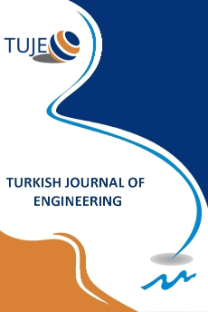THE REMOVAL OF NICKEL IONS WITH WALNUT SHELL
THE REMOVAL OF NICKEL IONS WITH WALNUT SHELL
___
- Altun, T., Pehlivan E. (2012). “Removal of Cr(VI) from aqueous solutions by modified walnut shells.” Food Chemistry, Vol. 132, pp. 693-700.
- Amari, T., Ghnaya, T., Abdelly, C. (2017). “Nickel, cadmium and lead phytotoxicity and potential of halophytic plants in heavy metal extraction.” South African Journal of Botany, Vol. 111, pp. 99-110.
- APHA (2005), Standard methods for the examination of water and wastewater, American Public Health Association (ALPHA): Washington, DC, USA.
- Cao, S.-J., Lin, X.-J., Fang, F., Zhang, T.-M., Hu, R.-Z. (2014). “A new absorbent by modifying walnut shell for the removal of anionic dye: Kinetic and thermodynamic studies.” Bioresource Techonology, Vol. 163, pp. 199- 205.
- Çelebi, H., Gök, O. (2015). “Evaluation of lead adsorption.” International Journal of Environmental Research, Vol. 11, pp. 83-90.
- El Samrani, A.G., Lartiges, B.S., Villieras, F. (2008). “Chemical coagulation of combined sewer overflow: Heavy metal removal and treatment optimization.” Water Research, Vol. 42, pp. 951-960.
- Feizi, M., Jalali, M. (2015) “Removal of heavy metals from aqueous solutions using sunflower, potato, canola and walnut shell residues.” Journal of Taiwan Institute of Chemical Engineers, Vol. 54, pp. 125-136.
- Ghaee, A., Shariaty-Niassar, M., Barzin, J., Zarghan, A. (2012). “Adsorption of copper and nickel ions on macroporous chitosan membrane: equilibrium study.” Applied Surface Science, Vol. 258, pp. 7732–7743.
- Gupta V.K., Ali L. (2000). “Utilization of bagasse fly ash (a sugar industry waste) for the removal of copper and zinc from wastewater.” Separation and Purification Technology, Vol, 18, pp. 131-140.
- Gupta V.K., Ali L. (2004). “Removal of lead and chromium from wastewater using bagasse fly ash – a sugar industry waste.” Journal of Colloid and Interface Science, Vol, 271, pp. 321-328.
- Gupta, V.K., Jain, C.K., Ali, L., Sharma, M., Saini, V.K. (2003). “Removal of cadmium and nickel from wastewater using bagasse fly ash – a sugar industry waste.” Water Research, Vol. 37, pp. 4038-4044.
- Kobielska, A.P., Howarth, J. A., Farha, K. O., Nayak, S.(2018). “Metal-organic frameworks for heavy metal removal from water.” Coordination Chemistry Reviews, Vol. 358, pp. 92-107.
- Mangaleshwaran, L., Thirulogachandar, A., Rajasekar, V. Muthukumaran, C.,Rasappan, K. (2015). “Batch and fixed bed column studies on nickel (II) adsorption from aqueous solution by treated polyurethane foam.” Journal of the Taiwan Institute of Chemical Engineers, Vol. 55, pp. 112–118.
- Mauchauffee, S., Meux, E. (2007). “Use of sodium decanoate for selective precipitation of metals contained in industrial wastewater.” Chemospher, Vol. 69, pp.763- 768.
- Mohsen-Nia, M., Montazeri, P., Modarress H. (2007). “Removal of Cu2+ and Ni2+ from wastewater with a chelating agent and reverse osmosis processes.” Desalination, Vol. 217, pp. 276-281.
- Ong, C.D., Kan, C.-C., Mae, S., Pingul-Ong, B., Daniel, M., de Luna, G. (2017). “Utilization of groundwater treatment plant (GWTP) sludge for nickel removal from aqueous solutions: Isotherm and kinetic studies.” Journal of Environmental Chemical Engineering, Vol. 5, pp. 5746-5753.
- Raval, N.P., Shah, P.U., Shah, N.K. (2016). “Adsorptive removal of nickel(II) ions from aqueous environment: a review.” Journal of Environmental Management, Vol. 179, pp. 1–20.
- Verma,V.K., Tewari, S., Rai, J.P.N. (2008). “Ion exchange during heavy metal bio-sorption from aqueous solution by dried biomass of macrophytes.” Bioresource Technolgy, Vol. 99, pp. 1932-1938.
- Verma,V.K., Tewari, S., Rai, J.P.N. (2008). “Ion exchange during heavy metal bio-sorption from aqueous solution by dried biomass of macrophytes.” Bioresource Technolgy, Vol. 99, pp. 1932-1938.
- Whang, S.X., Li, Z.Z., Tao, R.S. (2009). “Removal of chromium (VI) from aqueous solution using walnut hull.” Journal of Environmental Management, Vol. 90, pp.721- 729.
- Zabihi, M., Ahmadpour, A., Asl, H. A. (2009). “Removal of mercury from water by carbonaceous sorbents derived from walnut shell.” Journal of Hazardous Materials, Vol, 167, pp. 230-236.
- ISSN: 2587-1366
- Yayın Aralığı: 4
- Başlangıç: 2017
- Yayıncı: Mersin Uüniversitesi
ANTIBIOTIC APPLICATIONS IN FISH FARMS AND ENVIRONMENTAL PROBLEMS
Tolga Bahadır, Hakan Çelebi, İsmail Şimşek, Şevket Tulun
THE REMOVAL OF NICKEL IONS WITH WALNUT SHELL
Tolga Bahadır, İsmail Şimşek, Şevket Tulun, Mustafa Karataş
Şevket TULUN, Tolga BAHADIR, İsmail ŞİMŞEK, Mustafa KARATAŞ
TUNCAY ŞİMŞEK, Mustafa BARİŞ, Sadan OZCAN, ADNAN AKKURT
Tolga BAHADIR, Hakan ÇELEBİ, İsmail ŞİMŞEK, Şevket TULUN
THE BIOSYNTHESIS OF SILVER NANOPARTICLESBY CYTOPLASMIC FLUID OFCORIOLUS VERSICOLOR
Fatma DENİZ, Ali Osman ADİGÜZEL, Mehmet Ali MAZMANCİ
STUDY THE EFFECT OF HAIR STYLE PRODUCTS ON THE QUALITY OF DOMESTIC WASTEWATER-WAX AS CASE STUDY
Muhammed SALEH, Mutlu YALVAÇ, Ferhat SİME, Mehmet Ali MAZMANCİ
INVESTIGATION OF OXYGEN-RELATED DEFECTS IN ZnO:GROWING TIME AND MnCONCENTRATION EFFECTS
